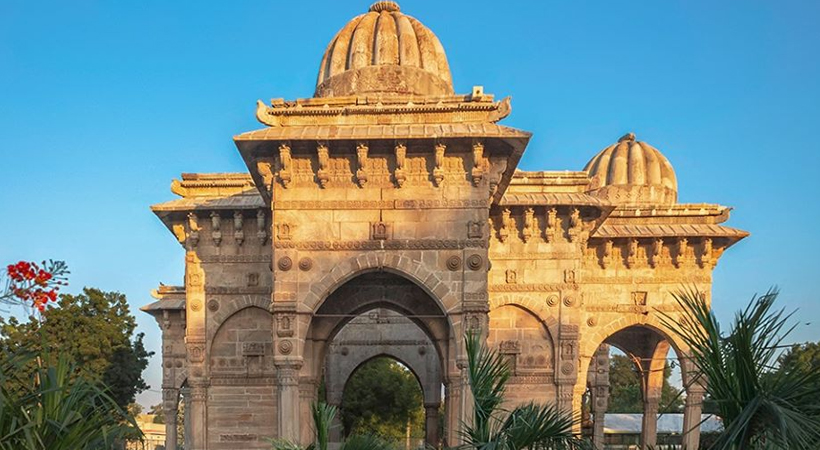Gujarat’s Heritage Tourism is a hidden gem

India’s Ministry of Tourism as part of its Dekho Apna Desh series held a webinar on “Heritage tourism in Gujarat”, presenting the fascinating and diverse heritage of the state of Gujarat ranging from ancient archaeological sites and majestic medieval monuments to modern architectural marvels.
Presented by Ranjit Sinh Parmar, Secretary-Heritage Tourism Association, Gujarat and Anil Mulchandani, author, travel writer and food critic, the webinar showcased the varied tourism products of Gujarat like its beautiful forts, palaces, havelis and other historical properties that have been converted into heritage hotels or opened as homestays.
The presenters recounted how being on the West coast of India with approximately 1600 kms of coastline, Gujarat had attracted traders, travellers, migrants and refugees from time immemorial. They highlighted the tangible and intangible heritage of Gujarat as well as the set of heritage hotels, homestays, museums, lifestyle event venues and film shooting locations that the state has to offer.
The glorious Gujarat is home to many ancient city ruins, palaces, forts and tombs, which stands proudly bearing testimony to the golden era of dynasties. Since its inception, landscapes of Gujarat have been ruled by rulers of many dynasties, invaders and sellers. Gujarat’s past is a part of its current terrains, evidenced by the ancient and historical ruins scattered across the country.
The state encompasses some sites of the ancient Indus Valley Civilisation, such as Lothal, Dholavira and Gola Dhoro. Lothal is believed to be one of the world’s first seaports. Gujarat’s coastal cities, chiefly Bharuch and Khambhat, served as ports and trading centres in the Maurya and Gupta empires, and during the succession of royal Saka dynasties from the Western Satraps era.
In the 1600s, the Dutch, French, English and Portuguese all established bases along the western coast of the region. Portugal was the first European power to arrive in Gujarat, and after the Battle of Diu, acquired several enclaves along the Gujarati coast, including Daman and Diu as well as Dadra and Nagar Haveli. These enclaves were administered by Portuguese India under a single union territory for over 450 years, only to be later incorporated into the Republic of India on 19 December 1961 by military conquest.
The webinar gave a virtual view of different aspects of Gujarat starting with the architectural trail in North Gujarat bordering the state of Rajasthan, showcasing Rani Ki Vav, Kumbariya Jain temple etc. Rani Ki Vav is an 11th century stepwell and has been declared a World Heritage site by UNESCO.
With regards to architecture, Gujarat entered a golden phase with the Solanki dynasty during the 11th & 12th century. The rulers of this dynasty had commissioned imposing forts and palaces at Jhinjwadaand Dabhoi, having exquisite carved gateways. Also, here are few of the best Hindu temples of the country like Rudramalaya at Sidhapur, Sun Temple at Modhera, Jain Temples at Palitana, Taranga, Girnar, Mt. Abu and Kumbhhariyaji. The distinctive feature noticed about this particular period is the development of water retaining structures such as the vavs (stepwells), kunds (stepped tanks) and talaos (lakes). They had been created for tapping the region’s limited water resources.
Walking down the steps will lead to view the beautifully crafted stone sculptures upon the walls. It includes Goddess Durga and Vishnu Avatars. Close to the step-well is the Saharasralinga talao, which is an artificial lake that is enclosed by beautifully carved Shiva shrines.
The walled city of Ahmedabad was founded by Sultan Ahmad Shah in 1411 AD on the eastern bank of the Sabarmati River is now UNESCO World heritage site.
Its urban archaeology strengthens its historic significance on the basis of remains from the Pre-Sultanate and Sultanate periods. The architecture of the Sultanate period monuments exhibits a unique fusion of the multicultural character of the historic city. This heritage is associated with the complementary traditions embodied in other religious buildings and the old city’s very rich domestic wooden architecture with its distinctive “havelis” (neighbourhoods), “pols” (gated residential main streets), and khadkis (inner entrances to the pols) as the main constituents. These latter are presented as an expression of community organizational network, since they also constitute an integral component of the urban heritage of Ahmedabad. An heritage walk was coneptualised in 1980 in Ahmedabad with some attractions like Swaminarayan temple, Dodiya Haveli, Fernandez Bridge, Jama Masjid etc.
Other important archaeological Sites of Gujarat include Lothal, Princely cities, towns, forts, sacred summits of Jainism, Rukmani temple Dwarka, Mandvi Palace, Palitana, Dholavira, Dwarka Gomati ghats, beautiful shore temple Somnath, the grandeur of Vadodra and East Gujarat with palaces of Raipipla, Santrampur, Lunavade, Devgadh Baria, Chhota Udepur, Jamnbughoda etc which have been converted into hotels where one can experience the royal grandeur of the palaces. Statue of Unity, Botanical garden, Safari park, Lakshmi Vilas Palace, Champaner are not be missed. In South Gujarat, one can witness the European heritage. The Dutch East India Company had trade centers in Surat. The itinerary can also include the living legacies of Gujarat in the form of parsi heritage, Navsari, Fire temple and diversity of food.
Vibrant Gujarat offers lot of colours to its fairs and festivals with rich cultural traditions, and has traditions of different ethnic and religious communities. The festivals celebrated here include Ganesh Chaturthi, Navaratri and Diwali. The celebration includes the annual kite festival on 14 January. The embroidery of Rabaris, geometric pattern and the rich textile like Patola and the double Ikat process are not to be missed.
Most of the heritage venues all across Gujarat especially the Palace of Vadodra (Baroda), Bhavnagar, Khirasara (Rajkot) etc are popular venues for MICE, wedding and many national and international events. Being close to Mumbai, Gujarat also offers good option for film shooting, short films, TV serials, Documentaries, Reality shows, pre wedding shoots, fashion shoots etc.
Summing up the webinar Rupinder Brar, Additional Director General, Ministry of Tourism stressed the importance of travelling and experiencing the diverse culture, architecture and cuisine of the heritage state.







